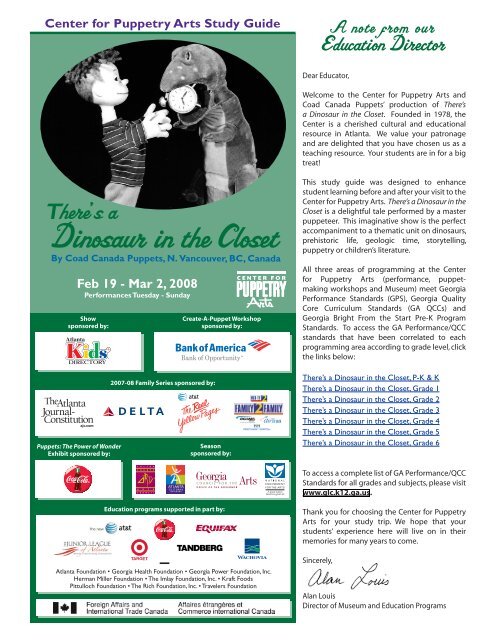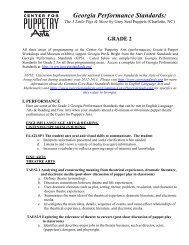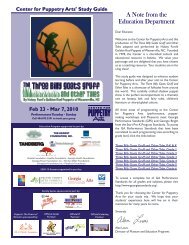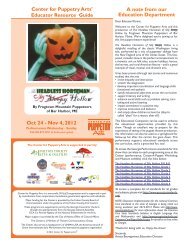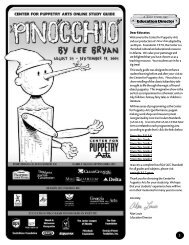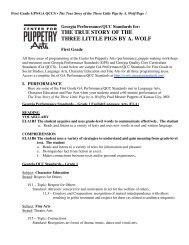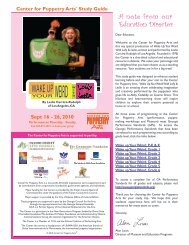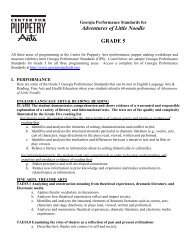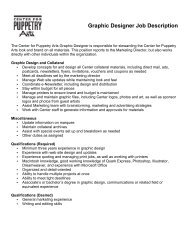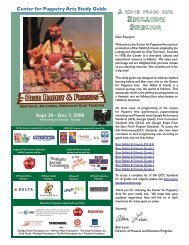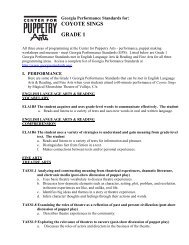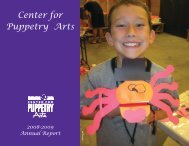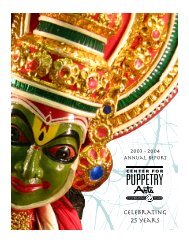You also want an ePaper? Increase the reach of your titles
YUMPU automatically turns print PDFs into web optimized ePapers that Google loves.
<strong>Center</strong> <strong>for</strong> <strong>Puppetry</strong> <strong>Arts</strong> <strong>Study</strong> <strong>Guide</strong><br />
A note from our<br />
Education Director<br />
Dear Educator,<br />
Welcome to the <strong>Center</strong> <strong>for</strong> <strong>Puppetry</strong> <strong>Arts</strong> and<br />
Coad Canada Puppets’ production of There’s<br />
a Dinosaur in the Closet. Founded in 1978, the<br />
<strong>Center</strong> is a cherished cultural and educational<br />
resource in Atlanta. We value your patronage<br />
and are delighted that you have chosen us as a<br />
teaching resource. Your students are in <strong>for</strong> a big<br />
treat!<br />
This study guide was designed to enhance<br />
student learning be<strong>for</strong>e and after your visit to the<br />
<strong>Center</strong> <strong>for</strong> <strong>Puppetry</strong> <strong>Arts</strong>. There’s a Dinosaur in the<br />
Closet is a delightful tale per<strong>for</strong>med by a master<br />
puppeteer. This imaginative show is the perfect<br />
accompaniment to a thematic unit on dinosaurs,<br />
prehistoric life, geologic time, storytelling,<br />
puppetry or children’s literature.<br />
Feb 19 - Mar 2, 2008<br />
Per<strong>for</strong>mances Tuesday - Sunday<br />
Show<br />
sponsored by:<br />
Puppets: The Power of Wonder<br />
Exhibit sponsored by:<br />
2007-08 Family Series sponsored by:<br />
Create-A-Puppet Workshop<br />
sponsored by:<br />
Season<br />
sponsored by:<br />
All three areas of programming at the <strong>Center</strong><br />
<strong>for</strong> <strong>Puppetry</strong> <strong>Arts</strong> (per<strong>for</strong>mance, puppetmaking<br />
workshops and Museum) meet Georgia<br />
Per<strong>for</strong>mance Standards (GPS), Georgia Quality<br />
Core Curriculum Standards (GA QCCs) and<br />
Georgia Bright From the Start Pre-K Program<br />
Standards. To access the GA Per<strong>for</strong>mance/QCC<br />
standards that have been correlated to each<br />
programming area according to grade level, click<br />
the links below:<br />
There’s a Dinosaur in the Closet, P-K & K<br />
There’s a Dinosaur in the Closet, Grade 1<br />
There’s a Dinosaur in the Closet, Grade 2<br />
There’s a Dinosaur in the Closet, Grade 3<br />
There’s a Dinosaur in the Closet, Grade 4<br />
There’s a Dinosaur in the Closet, Grade 5<br />
There’s a Dinosaur in the Closet, Grade 6<br />
To access a complete list of GA Per<strong>for</strong>mance/QCC<br />
Standards <strong>for</strong> all grades and subjects, please visit<br />
www.glc.k12.ga.us.<br />
Education programs supported in part by:<br />
Atlanta Foundation • Georgia Health Foundation • Georgia Power Foundation, Inc.<br />
Herman Miller Foundation • The Imlay Foundation, Inc. • Kraft Foods<br />
Pittulloch Foundation • The Rich Foundation, Inc. • Travelers Foundation<br />
Thank you <strong>for</strong> choosing the <strong>Center</strong> <strong>for</strong> <strong>Puppetry</strong><br />
<strong>Arts</strong> <strong>for</strong> your study trip. We hope that your<br />
students’ experience here will live on in their<br />
memories <strong>for</strong> many years to come.<br />
Sincerely,<br />
Alan Louis<br />
Director of Museum and Education Programs
Luman Coad was born in Buhl, Idaho. He studied<br />
children’s theatre at San Francisco State University. As<br />
a college student, he was director of the puppet theatre<br />
at Children’s Fairyland in Oakland, CA, and won his first<br />
international puppetry award at the age of 23.<br />
In 1966 he moved to Vancouver, British Columbia, and<br />
co-founded Coad Canada Puppets with his wife Arlyn<br />
Coad. An outstanding puppet mime artist, Luman’s work<br />
has been seen on such television shows as “Stargate SG-<br />
1” and in feature films such as “Being John Malkovich.”<br />
He was the founding secretary of the Canadian Centre<br />
of Union Internationale de la Marionnette (UNIMA) and<br />
has served on numerous committees of the Puppeteers<br />
of America.<br />
Luman’s company has per<strong>for</strong>med throughout North<br />
America as well as seventeen countries across Europe,<br />
the Middle East, South America, and the Pacific Rim.<br />
The troupe has won numerous major puppetry awards<br />
including First Prize at the 1977 International Festival<br />
of Puppet-Actors in Poland, and both the Puppeteers<br />
of America Trustees’ Award and the President’s Award<br />
(the highest honors in North American puppetry).<br />
The American Centre of Union Internationale de la<br />
Marionnette has awarded the Coads six Citations of<br />
Excellence in the Art of <strong>Puppetry</strong>. In 1987 they set up<br />
Charlemagne Press to publish books of advanced level<br />
puppetry and related topics. Over twenty titles are<br />
currently available.<br />
Each year Coad Canada Puppets create a new show<br />
<strong>for</strong> a solo per<strong>for</strong>mer which tours <strong>for</strong> eight months to<br />
elementary schools throughout British Columbia as well<br />
as children’s festivals across Canada.<br />
About the Artist<br />
Luman Coad<br />
Synopsis<br />
Despite his frequent appeals, Darryl is <strong>for</strong>bidden to keep<br />
a pet. One day he smuggles a large “pet” rock into his<br />
room. Imagine his surprise when out of this rock pops a<br />
small and very hungry dinosaur! Now Darryl’s problems<br />
really begin. What does it eat? How can he train it? Why<br />
is it growing so quickly? And most importantly, how can<br />
he keep his new pet hidden in his room? But Darryl can’t<br />
keep it a secret <strong>for</strong> long. What will Aunt Amelia do when<br />
she discovers that his pet rock has turned into a gigantic<br />
pet dinosaur?<br />
Style of <strong>Puppetry</strong><br />
There’s a Dinosaur in the Closet is per<strong>for</strong>med with hand<br />
puppets by a solo puppeteer. Hand puppets are figures<br />
that are brought to life when a puppeteer places his/her<br />
hand inside the puppet’s glove-like body. The puppeteer<br />
manipulates a hand puppet with his/her fingers and<br />
wrist so that the puppet characters become extensions<br />
of the puppeteer’s own hands.<br />
2
Bibliography<br />
• Dingus, Lowell, et al. Dinosaur Eggs Discovered: Unscrambling the Clues. Twenty-First Century<br />
Books, 2007.<br />
• Dixon, Dougal. Cretaceous Life (Prehistoric World). Barron’s Educational Series, 2006.<br />
• Dixon, Dougal. If Dinosaurs Were Alive Today. Running Press Kids, 2007.<br />
• Hoff, Syd. Danny and the Dinosaur. HarperTrophy, 1992.<br />
• Holtz, Jr., Dr. Thomas R. Dinosaurs: The Most Complete, Up-to-Date Encyclopedia <strong>for</strong> Dinosaur<br />
Lovers of All Ages. Random House Books <strong>for</strong> Young Readers, 2007.<br />
• Pallotta, Jerry. The Dinosaur Alphabet Book. Charlesbridge Publishing, 1990.<br />
• Potts, Aidan. Uneversaurus. David Fickling Books, 2007.<br />
• Priddy, Roger. My Big Dinosaur Book. Priddy Books, 2004.<br />
• Rey, Luis V. Extreme Dinosaurs. Amazon Remainders Account, 2001.<br />
• Sharfe, Elaine. There’s a Dinosaur in My Room. Chestnut Publishing Group, 2005.<br />
• Tanaka, Shelley. New Dinos : The Latest Finds! The Coolest Dinosaur Discoveries! Atheneum, 2003.<br />
• Yolen, Jane. How Do Dinosaurs Play With Their Friends? The Blue Sky Press, 2006.<br />
• Zimmerman, Howard. Dinosaurs! The Biggest Baddest Strangest Fastest. Atheneum Books, 2000.<br />
Darryl and Dinosaur playing tug in a<br />
scene from There’s a Dinosaur in the Closet<br />
3
http://www.dinodon.com/index.htm<br />
Meet Dino Don, author of 25 books on dinosaurs.<br />
Internet Resources<br />
http://paleobiology.si.edu/dinosaurs/index.html<br />
Visit the dinosaurs Web page created by the Smithsonian’s National Museum of Natural History in<br />
Washington, D.C.<br />
http://pubs.usgs.gov/gip/dinosaurs/<br />
Find answers to your questions about dinosaurs at this Web site produced by the U.S. government.<br />
http://dsc.discovery.com/guides/dinosaur/dinosaur.html<br />
Take an interactive dinosaur tour at Discovery.com.<br />
http://www.livescience.com/dinosaurs/<br />
You’ll find lots of great in<strong>for</strong>mation on dinosaurs at Live Science.com.<br />
http://www.newscientist.com/channel/life/dinosaurs<br />
Visit New Scientist.com’s comprehensive dinosaur site.<br />
http://www.coadcanadapuppets.com/<br />
Check out what’s new at Coad Canada Puppets on the Web.<br />
http://members.shaw.ca/charlemagnepress/welcome..htm<br />
Shop <strong>for</strong> puppetry books at Luman Coad’s Charlemagne Press online.<br />
http://www.fairyland.org/<br />
Visit the historic Children’s Fairyland in Oakland, Cali<strong>for</strong>nia where puppeteer Luman Coad began his<br />
career. First open to the public in 1950, this children’s theme park still continues its tradition of puppet<br />
shows <strong>for</strong> young children.<br />
Darryl’s pet rock hatches in a scene from<br />
There’s a Dinosaur in the Closet<br />
4
Learning Activities<br />
P-K & K: Dinosaurs Patterning Activity<br />
Georgia Bright from the Start Pre-K Content Standards covered: Mathematical Development<br />
MD 2 b (Children will create and duplicate simple patterns). Georgia Per<strong>for</strong>mance Standards<br />
covered: Kindergarten, Mathematics (Geometry) MKG3B.<br />
Objective: Students will identify simple picture patterns and select a picture from the list that<br />
completes each pattern.<br />
Materials: Dinosaurs patterning handout from this study guide, scissors, glue, glue sticks or paste,<br />
crayons, chart paper and markers.<br />
Procedure:<br />
1. Reproduce Dinosaur patterning handouts so that there are enough <strong>for</strong> each student.<br />
2. Be<strong>for</strong>e distributing handouts, draw a few simple patterns with geometric shapes on the<br />
board or on chart paper. Say the names of the shapes out loud as you point to them.<br />
For example, “Triangle, circle, square, triangle, circle, square.”<br />
3. Draw a different sample pattern and ask students to identify the patterns in each row, saying<br />
the name of the shape out loud as they “read” the picture of the shape.<br />
4. Distribute dinosaur pattern handouts. Review the names of the dinosaurs with students.<br />
The dinosaurs pictured on the handout are: T-Rex, Stegosaurus, Apatosaurus and<br />
Triceratops.<br />
5. Asks students to cut out the squares along the bottom of the page and glue them at the<br />
end of each row to complete each pattern. Ask them to say the names of the dinosaurs<br />
aloud to help them recognize the pattern if they are having difficulty doing it visually.<br />
6. When all the patterns have been completed, ask students to color their sheets.<br />
Assessment: Collect student handouts <strong>for</strong> review. Check <strong>for</strong> accuracy and remediate as necessary. Save<br />
work samples <strong>for</strong> mathematics portfolios or classroom bulletin board display.<br />
5
Name___________________________________________ Date_______________________<br />
Dinosaur Patterns<br />
Directions: Cut out the pictures below. Paste one picture in each square that will<br />
complete the pattern <strong>for</strong> that row. You will use all but one picture.
1st & 2nd Grade: Write Your Own Fantasy Dinosaur Story<br />
Georgia Per<strong>for</strong>mance Standards covered: Grade 1, English/Language <strong>Arts</strong>, Writing, ELA1W1a,c,d,e,<br />
f,g,h,i,j,l,m; Grade 2, English/Language <strong>Arts</strong>, Writing, ELA2W1a,b,c, h,i,j,k,l,m,p,q,r.<br />
Objective: Students will write and illustrate their own fantasy dinosaur story in book <strong>for</strong>m after<br />
attending a per<strong>for</strong>mance of Coad Canada Puppets’ There’s a Dinosaur in the Closet.<br />
Materials: Chart paper, markers, paper, pencils (or computers with word processing software and<br />
printers), crayons, construction paper.<br />
Procedure:<br />
Learning Activities<br />
1. After attending a per<strong>for</strong>mance of There’s a Dinosaur in the Closet at the <strong>Center</strong> <strong>for</strong><br />
<strong>Puppetry</strong> <strong>Arts</strong>, divide a piece of chart paper into three sections: one <strong>for</strong> the beginning of the<br />
story, one <strong>for</strong> the middle of the story and one <strong>for</strong> the end of the story. Label each section:<br />
beginning, middle and end.<br />
2. Ask students to recall what happened at each point in the story and fill in the details on the<br />
chart paper.<br />
3. Ask them to think of ideas <strong>for</strong> their own fantasy dinosaur story about their own encounter<br />
with a dinosaur. What kind of dinosaur might they meet? What might happen to the<br />
dinosaur? What might happen to the student? Ask them to fill in their ideas on a piece of<br />
paper (or a computer) <strong>for</strong> the beginning, middle and end of their stories just like the class<br />
did <strong>for</strong> There’s a Dinosaur in the Closet.<br />
4. Have students pre-write to generate ideas, create a first draft, revise their first draft, edit<br />
their work and finally publish it in book <strong>for</strong>m accompanied by illustrations. Remind them<br />
that their stories must have a clear beginning, middle and end. Use the structure of There’s<br />
a Dinosaur in the Closet as an example.<br />
5. Ask students to share their stories with the class.<br />
Assessment: Check students’ work <strong>for</strong> spelling, punctuation and grammar. Do their stories have a<br />
clear beginning, middle and end? Save books <strong>for</strong> language arts portfolios.<br />
7
3rd & 4th Grade: Research Your Favorite Dinosaur<br />
Georgia Per<strong>for</strong>mance Standards covered: Grade 3, English/Language <strong>Arts</strong> (ELA), Writing, ELA3W1.<br />
Grade 4, Language <strong>Arts</strong>, Written Communication (Reading): 13, 16, 17, 21; (Writing): 39, 40, 41. Social<br />
Studies, Core Social Studies Skills (In<strong>for</strong>mation Processing): 24, 25, 26, 36. Georgia Per<strong>for</strong>mance<br />
Standards covered: Grade 4, English/Language <strong>Arts</strong> (ELA), Writing, ELA4W2.<br />
Objective: Students will select a dinosaur to research and then write a report on their findings.<br />
Materials: Paper, pencils, computers with Internet access, access to school media center and/or<br />
public library.<br />
Procedure:<br />
Learning Activities<br />
1. Prewriting. Teacher should guide students through a brainstorming session to list different<br />
dinosaurs such as Tyrannosaurus Rex, Apatosaurus, Stegosaurus, Triceratops,<br />
Pterodactyl, etc.<br />
2. Research. Ask each student to select a type of dinosaur that they would like to learn more<br />
about. Once they have chosen a dinosaur to research, they should locate books,<br />
encyclopedias, digital media and Web sites on the Internet to gather in<strong>for</strong>mation about<br />
their species. They may also conduct an interview with a paleontologist in person, by email<br />
or by telephone.<br />
3. Drafting. Students should use research finding to complete the first draft. Ask students to<br />
address the following points:<br />
• Describe your dinosaur’s appearance.<br />
• In what geologic period did your dinosaur live?<br />
• In what sort of habitat did your dinosaur live?<br />
• What foods made up your dinosaur’s diet?<br />
• How did your dinosaur organize socially? (Alone or in groups?)<br />
• How many eggs did the females usually lay at one time?<br />
4. Revising and editing. Have students prepare a first draft of their report <strong>for</strong> editing.<br />
5. Publishing. Final drafts should be presented be<strong>for</strong>e the class.<br />
Assessment: Check to see if students have followed the writing process: prewriting, drafting, editing,<br />
publishing. Save finished reports <strong>for</strong> student writing portfolios.<br />
8
Learning Activities<br />
5th and 6th Grade: Dinosaur Egg Discovery: A Word Search Puzzle<br />
Georgia Per<strong>for</strong>mance Standards covered: Grade 5, English/Language <strong>Arts</strong>, Reading, ELA5R3a,b,<br />
c,d,e,f; Grade 6, English/Language <strong>Arts</strong>, Reading, ELA6R2a,b,c,d.<br />
Objective: Students will read a paragraph about dinosaur eggs and complete a word search puzzle<br />
featuring vocabulary words from the reading.<br />
Materials: Copies of word search puzzle handouts, pens, pencils or highlighters.<br />
Procedure:<br />
1. Have students read the paragraph about dinosaur egg discoveries at the bottom<br />
of the word search puzzle paying special attention to the words in bold face. Discuss the<br />
meaning of any unfamiliar words.<br />
2. After they have read the paragraph, ask them to locate the bolded words in the puzzle.<br />
Students should circle or highlight each word as they find it. Words are hidden vertically,<br />
horizontally, diagonally and backward.<br />
Assessment: Check student handouts <strong>for</strong> completion, comprehension and retention of in<strong>for</strong>mation.<br />
Remediate content from paragraph if necessary.<br />
1404 Spring Street, NW at 18th • Atlanta, Georgia USA 30309-2820<br />
Ticket Sales: 404.873.3391 • Administrative: 404.873.3089 • www.puppet.org • info@puppet.org<br />
Headquarters of UNIMA-USA • Member of Atlanta Coalition of Per<strong>for</strong>ming <strong>Arts</strong> and Theatre Communications Group<br />
Text by Alan Louis and Amy Ellis • Original artwork by Anthony Owsley • Copyright © <strong>Center</strong> <strong>for</strong> <strong>Puppetry</strong> <strong>Arts</strong> Education Dept., February 2008.<br />
© 2007 AT&T Intellectual Property. All rights reserved. AT&T,<br />
AT&T logo and all other marks contained herein are trademarks of<br />
AT&T Intellectual Property and/or AT&T affiliated companies.<br />
9
Name___________________________________________<br />
Date ____________________<br />
Dinosaur Eggs Discovered!<br />
A Word Search Puzzle<br />
Directions: Read the paragraph below about dinosaur eggs. Locate all 13 bolded words in the puzzle. Circle<br />
or highlight each word as you find it. Words are hidden vertically, horizontally, diagonally and backward.<br />
N M A S S I V E D H S O G A N<br />
H O E Q Q Y U X E Y C Z C I O<br />
E H I Y Y P M R M B I I H N I<br />
L N A T G X D T H B E O U O T<br />
C B O T C S Y R O M N H L G I<br />
A A Y A C U C U D S C K H A D<br />
K Y F I A H D B U E E P V T E<br />
A T S I G O L O T N O E L A P<br />
X Y U C W A E I R X D A C P X<br />
K U V N S C C H N P E Y E F E<br />
I T F Y A A Q C X G E M J W Z<br />
A P U T R Y Z G S X S R G I W<br />
G T E F O S S I L I Z E D L D<br />
A R A C X U C I N O Y R B M E<br />
C S G G E D I S C O V E R E D<br />
The science of dinosaur eggs and embryos is still relatively new. Compared to dinosaur bones, dinosaur<br />
eggs are rarely found and are much more difficult to study. In 1997, paleontologist Luis Chaippe made<br />
an exciting discovery when he found a chunk of embryonic skin inside a dinosaur egg while leading an<br />
expedition in Patagonia, the southernmost region of Argentina and Chile. This was the first time a scientist<br />
had ever seen fossilized dinosaur skin. Chiappe called it the highlight of his career. The eggs Chiappe and his<br />
team discovered represent the largest dinosaur nesting site ever discovered. The site was massive. They<br />
concluded that herds of dinosaurs from the Cretaceous Period were nesting and caring <strong>for</strong> their hatchlings<br />
on this site and returning time and time again when it was time to lay eggs. Important sites like this inspire<br />
new theories about dinosaur reproduction.<br />
10
<strong>Study</strong> <strong>Guide</strong> Feedback Form<br />
The following questions are intended <strong>for</strong> the teachers and group leaders<br />
who make use of the <strong>Center</strong> <strong>for</strong> <strong>Puppetry</strong> <strong>Arts</strong>’ study guides.<br />
1. In what grade are your students?<br />
2. Which show did you see? When?<br />
3. Was this your first time at the <strong>Center</strong>?<br />
4. Was this the first time you used a <strong>Study</strong> <strong>Guide</strong>?<br />
5. Did you download/use the guide be<strong>for</strong>e or after your field trip?<br />
6. Did you find the bibliography useful? If so, how?<br />
7. Did you find the list of online resources useful? If so, how?<br />
8. Did you reproduce the activity sheet <strong>for</strong> your grade?<br />
9. Additional in<strong>for</strong>mation and/or comments:<br />
Please fax back to the <strong>Center</strong> <strong>for</strong> <strong>Puppetry</strong> <strong>Arts</strong> at 404.873.9907.<br />
Your feedback will help us to better meet your needs. Thank you <strong>for</strong> your help!


